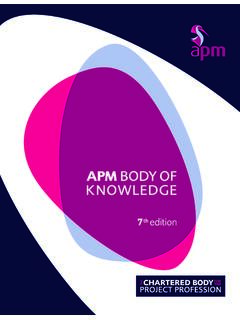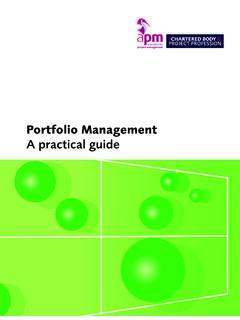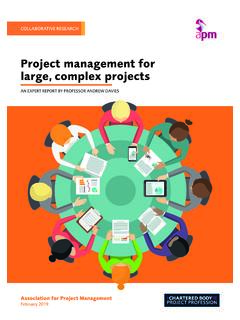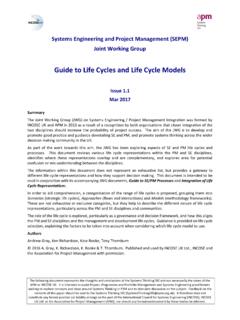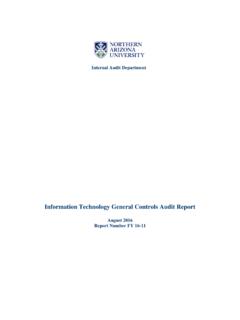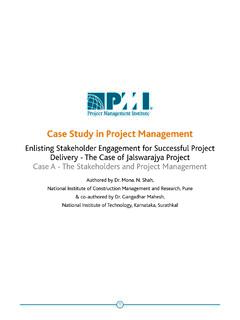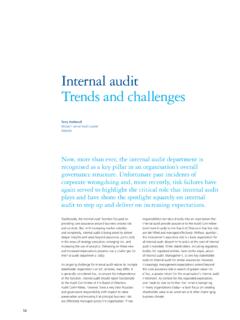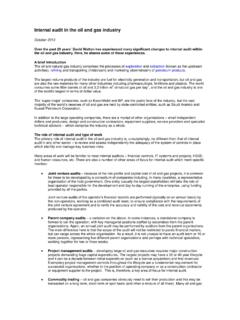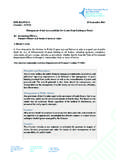Transcription of A Guide to Project Auditing - Association for Project ...
1 A Guide to Project AuditingAssociation for Project Management34641_00_FM to 113/04/2018 14:42iiiContents1 Introduction Introduction Purpose of the Guide Structure of the Guide What is Project Auditing ? Principles of Project audit Project life cycle Why do we need Project audits? Who should use the Guide ? The Project sponsor The Project team The Project auditor 62 Project audit process Planning the audit audit prioritisation Choosing the audit team Information gathering Risk assessing a Project The Project audit programme Fieldwork Elements for review Evaluation and reporting Evaluation Reporting Follow-up Benefits evaluation Legacy and lessons learned 13 Appendix 1 14 Matrix of element-based areas of review, risks and controls 14 Appendix 2 31 Comparison of Project audit elements for review.
2 With assurance measures toolkit categories 3134641_00_FM to 313/04/2018 14 IntroductionProject assurance is a fundamental part of effective Project governance. The Project audit is the means to provide that assurance and enables the sponsor to have confidence that the governance is working and that the Project is being managed as intended. There is currently a considerable amount of information relating to the assurance of projects and programmes, and why it is important. This Guide seeks to demonstrate how to plan and undertake a comprehensive audit of a Project , thereby providing that Guide seeks to explain the role of an audit , how it could be planned and undertaken, the degrees of assurance that can be given, and how Project audits can be aligned to organisational governance.
3 Although the Guide acknowledges the need for Project audits to be integrated with the works of other assurance providers (particularly technical and quality audits) a Project audit is a stand-alone process aimed at the three main roles involved in a three main roles involved in Project audits are:RoleDescriptionOrganisation board/ audit committee/sponsor/other stakeholdersThose who schedule the Project audit and receive the audit findingsProject teamThose whose Project is being audited, with whom the auditors interactProject auditor(s)
4 Those who undertake the audit , and report its findings and make recommendationsFor any audit to be successful and provide value to all parties, these three main roles must work together and understand each other s function in the is common in all projects it is vital that there is a recognition that people undertaking different Project roles may have differing interests and perceptions about Project outputs, progress and the various stakeholders. This Guide therefore 34641_00_FM to 113/04/2018 14:42A Guide to Project Auditing2refers to how audits relate to the various responsibilities within a Project and how to apply the processes associated with Auditing in a Project context taking Project responsibilities into consideration.
5 These processes include: the development of an annual audit plan; choosing the auditor/ audit team to undertake the work; developing an audit programme; performing, closing, and reporting the audit ; and undertaking Purpose of the guideThis Guide is principally intended for use by Project auditors in developing an audit approach to the review and assurance of projects. However, it is also intended to be of value to anyone involved in the management and administration of projects, as it records areas of Project risk, and identifies audit evidence and practices.
6 The Guide will also indicate those aspects of a Project which the auditors may choose to review, and how the audit will be Guide is not intended to provide step-by-step instructions on how to carry out audits on any particular type of Project ; rather, it will provide guidance which can be adapted by the user to the circumstances of their own projects. The audit can then be planned, performed and reported on, and based on the auditor s preferred approach, adapted to suit the particular Project section , and expanded in Appendix 1, the Guide proposes some elements and areas of interest for review by Project auditors, together with the risks and expected controls to manage those risks.
7 These elements do not form an exhaustive list so it is recommended that further assessment by the Project auditor is always necessary to decide upon areas of focus before a Project audit is Structure of the guideThe Guide focuses on the various aspects of Project audits, to answer the following three questions:n What is an audit ? (And how an audit differs from other assurance methods.)n Why do we undertake Project audits?n How should a Project audit be planned, performed, evaluated, reported, and followed up?34641_00_FM to 213/04/2018 14:423 IntroductionThis Guide covers the planning of Project audits (Section ); suggested elements of a Project which are to be reviewed (Section and Appendix 1); evaluation and reporting (Section ); and follow-up processes (Section ).
8 What is Project Auditing ? Auditing is defined by the Chartered Institute of Internal Auditors as an independent, objective assurance and consulting activity designed to add value and improve an organisation s operations. It helps an organisation accomplish its objectives by bringing a systematic, disciplined approach to evaluate and improve the effectiveness of risk management , control, and governance processes .In any audit , the auditor(s) perceives and recognises the propositions before them for examination, collects evidence, evaluates the same, and on this basis formulates an opinion on the adequacy of controls within the activity being this Guide we use the term Project to mean a unique, transient endeavour undertaken to achieve planned objectives (see APM Body of Knowledge, 6th edition); the audit of programmes and portfolios will require different techniques.
9 Auditing of a Project should be seen in the context of the definition of Project , programme and portfolio (P3) assurance set out in the APM Body of Knowledge: P3 Assurance is the process of providing confidence to stakeholders that projects, programmes and portfolios will achieve their scope, time, cost and quality objectives, and realise their benefits . Principles of Project auditThe APM publication A Guide to Integrated Assurance identifies the principles governing Project audit , which are those established for the provision of assurance generally.
10 Project audit should be:n independent, and supported in this by the organisation board;n accountable within a governance and reporting system;n planned and coordinated as part of the organisation s management system;n proportionate to risk potential and the assurance needs of stakeholders;n risk-based, against an independent risk evaluation;n able to allow the impact of identified weaknesses to be reported and addressed, by follow-up and to 313/04/2018 14:4215 Element 1. Project definition and requirements management : clear and controlled baseline requirements, objectives, success criteria, business case, terms of reference, contracts and benefits realisationArea of reviewRiskControlAudit methods includeBusiness plan alignmentThe programme/ Project is not aligned with organisation or business strategyFormal approval of Project start-up recorded and confirmation that it aligns with strategic objectivesReview of appropriate board minutes and documentationReview of stage gate (gateway)
